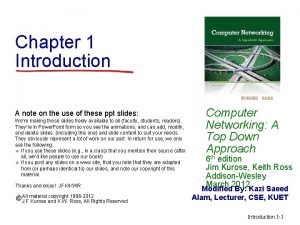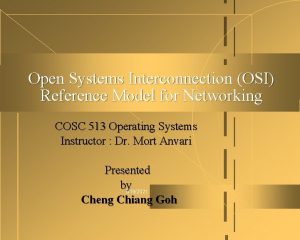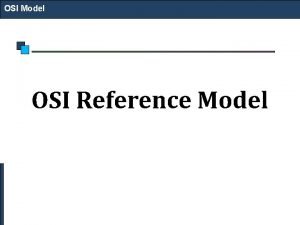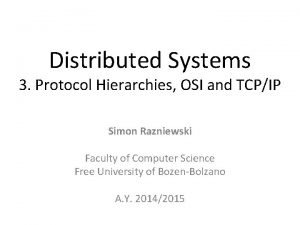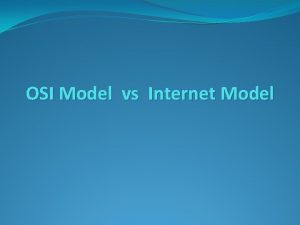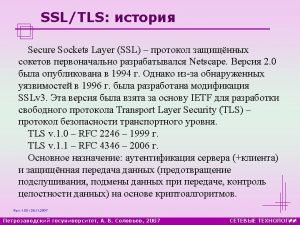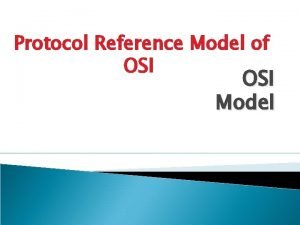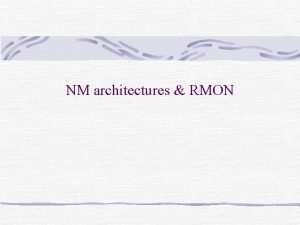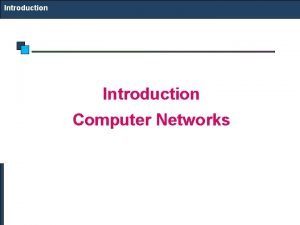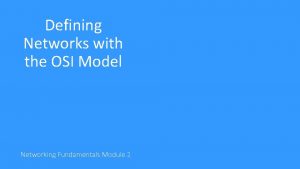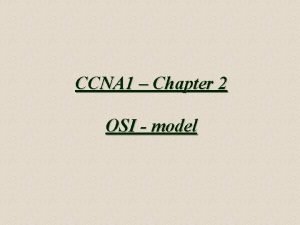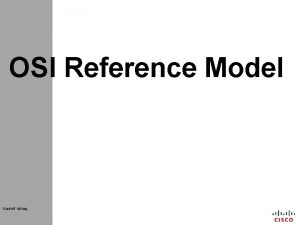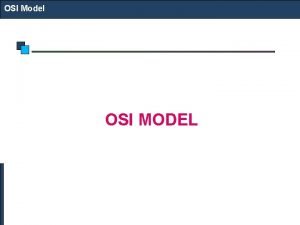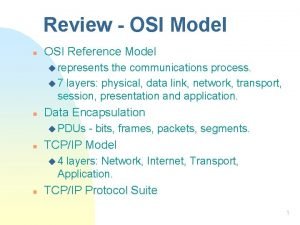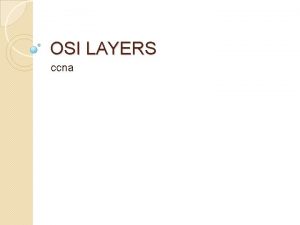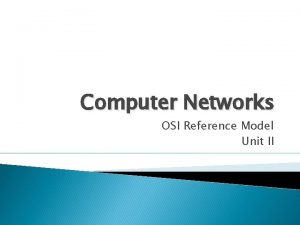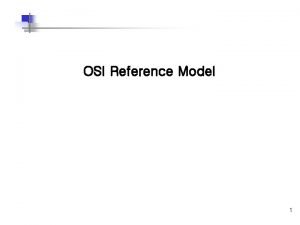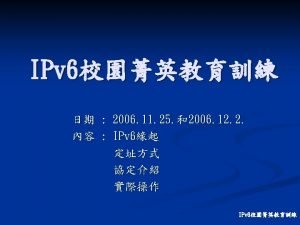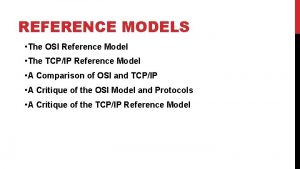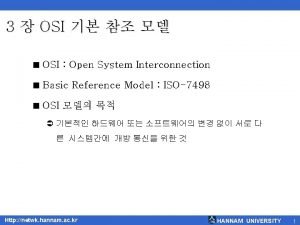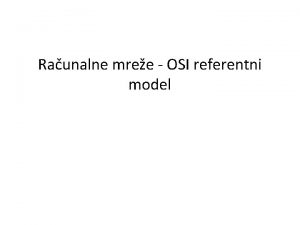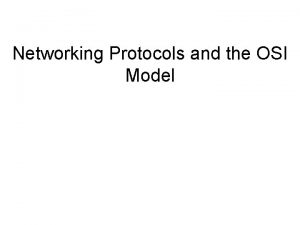The OSI Reference Model The OSI Model l
























- Slides: 24

The OSI Reference Model

The OSI Model l OSI “ Open Systems Interconnection". l OSI model was first introduced in 1984 by the International Organization for Standardization (ISO). l – Outlines WHAT needs to be done to send data from one computer to another. – Not HOW it should be done. – Protocols stacks handle how data is prepared for transmittal (to be transmitted) In the OSI model, The specification needed – are contained in 7 different layers that interact with each other.

7 Layer OSI Model l Why use a reference model? – – Serves as an outline of rules for how protocols can be used to allow communication between computers. Each layer has its own function and provides support to other layers. l As computing requirements increased, the network modeling had to evolve to meet ever increasing demands of larger networks and multiple venders. l Problems and technology advances also added to the demands for changes in network modeling.

What Each Layer Does 2

l Gives end-user applications access to network resources l Where is it on my computer? – Workstation or Server Service in MS Windows 3

Presentation Layer 3

Session Layer l Allows applications to maintain an ongoing session l Where is it on my computer? – Workstation and Server Service (MS) – Windows Client for Net. Ware (Net. Ware) 3

Transport Layer l l Provides reliable data delivery It’s the TCP in TCP/IP l Receives info from upper layers and segments it into packets l Can provide error detection and correction 3

Figure 2. 9 Transport layer The transport layer is responsible for the delivery of a message from one process to another.

Network Layer l Provides network-wide addressing and a mechanism to move packets between networks (routing) l Responsibilities: – Network addressing – Routing l Example: – IP from TCP/IP 3

Network layer The network layer is responsible for the delivery of individual packets from the source host to the destination host.

Network Addresses l l Network-wide addresses Used to transfer data across subnets Used by routers for packet forwarding Example: – l IP Address Where is it on my computer? – TCP/IP Software

Data Link Layer l Places data and retrieves it from the physical layer and provides error detection capabilities 3

Data link layer The data link layer is responsible for moving frames from one hop (node) to the next.

Sub-layers of the Data Link Layer l MAC (Media Access Control) – – l Gives data to the NIC Controls access to the media through: l CSMA/CD Carrier Sense Multiple Access/Collision Detection l Token passing LLC (Logical Link Layer) – – Manages the data link interface (or Service Access Points (SAPs)) Can detect some transmission errors using a Cyclic Redundancy Check (CRC). If the packet is bad the LLC will request the sender to resend that particular packet.

Physical Layer l Determines the specs for all physical components – – l Cabling Interconnect methods (topology / devices) Data encoding (bits to waves) Electrical properties Examples: – – – Ethernet (IEEE 802. 3) Token Ring (IEEE 802. 5) Wireless (IEEE 802. 11 b) 3

Physical layer The physical layer is responsible for the movement of individual bits from one hop (node) to the next.

Physical Layer (cont’d) l l What are the Physical Layer components on my computer? NIC – – – l Network Interface Card Has a unique 12 character Hexadecimal number permanently burned into it at the manufacturer. The number is the MAC Address/Physical address of a computer Cabling – – – Twister Pair Fiber Optic Coax Cable

Encapsulation example: E-mail

Encapsulation

Figure 2. 3 An exchange using the OSI model

Figure 2. 14 Summary of layers

The Postal Analogy How would the OSI compare to the regular Post Office Application l A- Write a 20 page letter to a foreign country. Presentation l P- Translate the letter so the receiver can read it. Session l S- Insure the intended recipient can receive letter. l T- Separate and number pages. Like registered mail, tracks delivery and requests another package if one is “lost” or “damaged” in the mail. N- Postal Center sorting letters by zip code to route them closer to destination. D- Local Post Office determining which vehicles to deliver letters. P- Physical Trucks, Planes, Rail, autos, etc which carry letter between stations. Transport Network l Data-Link l Physical l

Remembering the 7 Layers 7 - Application All 6 - Presentation People 5 - Session Seem 4 - Transport To 3 - Network Need 2 - Data Link Data 1 - Physical Processing
 Explain osi reference model
Explain osi reference model They relay packets among multiple interconnected networks
They relay packets among multiple interconnected networks Osi modle
Osi modle Disadvantages of osi reference model
Disadvantages of osi reference model Osi model diagram
Osi model diagram Osi model
Osi model Osi reference model
Osi reference model Reference node and non reference node
Reference node and non reference node Reference node and non reference node
Reference node and non reference node Osi model vs internet model
Osi model vs internet model Iso osi model
Iso osi model Osi model history
Osi model history Ssl osi
Ssl osi Snmp model in computer networks
Snmp model in computer networks Conclusion of osi model
Conclusion of osi model Osi network management model
Osi network management model Cmip network management
Cmip network management Osi network management model
Osi network management model Osi network management model
Osi network management model Iso osi model
Iso osi model Goals of computer network
Goals of computer network Which layer of the osi model includes vlans
Which layer of the osi model includes vlans X.800 security architecture
X.800 security architecture Osi model ccna
Osi model ccna Imon internet outage
Imon internet outage

